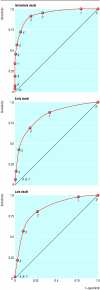Prognostic indicators of early and late death in children admitted to district hospital in Kenya: cohort study
- PMID: 12586667
- PMCID: PMC148891
- DOI: 10.1136/bmj.326.7385.361
Prognostic indicators of early and late death in children admitted to district hospital in Kenya: cohort study
Abstract
Objectives: To identify clinical indicators of immediate, early, and late mortality in children at admission to a sub-Saharan district hospital and to develop prognostic scores.
Design: Prospective cohort study.
Setting: One district hospital in Kenya.
Participants: Children aged over 90 days admitted to hospital from 1 July 1998 to 30 June 2001.
Main outcome measures: Prognostic indicators of mortality.
Results: Of 8091 children admitted up to 1 June 2000, 436 (5%) died. Sixty (14%) died within four hours after admission (immediate), 193 (44%) after 4-48 hours (early), and 183 (42%) after 48 hours (late). There were marked differences in the clinical features associated with immediate, early, and late death. Seven indicators (neurological status, respiratory distress (subcostal indrawing or deep breathing), nutritional status (wasting or kwashiorkor), severe anaemia, jaundice, axillary temperature, and length of history) were included in simplified prognostic scores. Data from 4802 children admitted from 1 July 2000 to 30 June 2001 were used to validate the scores. For simplified prognostic scores the areas under the receiver operating characteristic curves were 0.93 (95% confidence interval 0.92 to 0.94), 0.82 (0.80 to 0.83), and 0.82 (0.81 to 0.84) for immediate, early, and late death, respectively.
Conclusion: In children admitted to a sub-Saharan hospital, the prognostic indicators of early and late deaths differ but a small number of simple clinical signs predict outcome well.
Figures
References
-
- WHO. World health report 1999: making a difference. Geneva: WHO; 1999.
-
- Snow RW, Howard SC, Mung'Ala-Odera V, English M, Molyneux CS, Waruiru C, et al. Paediatric survival and re-admission risks following hospitalization on the Kenyan Coast. Trop Med Int Health. 2000;5:377–383. - PubMed
-
- Nolan T, Angos P, Cunha AJ, Muhe L, Qazi S, Simoes EA, et al. Quality of hospital care for seriously ill children in less-developed countries. Lancet. 2001;357:106–110. - PubMed
-
- WHO. Management of the child with a serious infection or severe malnutrition. Guidelines at the first referral level in developing countries. Geneva: WHO; 2000.
-
- Gove S, Tamburlini G, Molyneux E, Whitesell P, Campbell H. Development and technical basis of simplified guidelines for emergency triage assessment and treatment in developing countries. WHO integrated management of childhood illness (IMCI) referral care project. Arch Dis Child. 1999;81:473–477. - PMC - PubMed
Publication types
MeSH terms
Grants and funding
LinkOut - more resources
Full Text Sources

